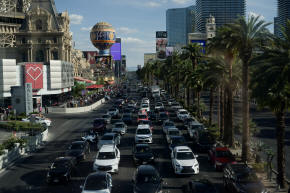U.S. economy not letting war, pandemic get in the way of a good time
 Send a link to a friend
Send a link to a friend
 [April 01, 2022] By
Howard Schneider [April 01, 2022] By
Howard Schneider
WASHINGTON (Reuters) - Fear that the war in
Ukraine would tilt the U.S. economy towards a 1970s-style bout of
stagflation has given way to signs that Americans plan to keep
traveling, returning to restaurants, and continuing a steady if still
incomplete return to "normal."
There remain major gaps in the post-pandemic economy. Downtown office
buildings are still underused in what may be one of the more persistent
changes as workers and employers realized many jobs could be done from
home; businesses still struggle to find supplies and hire workers at a
time of record job openings.
But following a winter in which war, a new coronavirus surge, and
already high inflation painted a potentially grim picture of even faster
rising prices and slowing growth, recent government and high-frequency
data show an expansion seemingly poised to roll on.
The monthly nonfarm payrolls report, due to be released on Friday, is
expected to show a gain of nearly 500,000 jobs in March and a further
drop in the unemployment rate to 3.7%, according to economists polled by
Reuters. High-frequency data from payroll providers like UKG and
Homebase showed hiring momentum continued through the end of the month
and likely into April.

Gasoline consumption did edge down in March as prices nationally topped
$4 a gallon, but Energy Information Administration data still shows
gasoline use remains around 95% of pre-pandemic levels, roughly where it
has been since the start of 2022.
Air travel is nearing 90% of pre-pandemic levels. Data from restaurant
reservation site OpenTable shows in-person dining at 95% of pre-pandemic
levels on 15 of the last 18 days through March 30.
Inflation, which is running at three times the Federal Reserve's 2%
target, may mean consumers are getting less for their money. Spending
data for February showed consumption actually declined on an
inflation-adjusted basis, and energy sapped a larger share of household
budgets.
That drop, however, came after a spending surge in January, and analysts
and Fed policymakers this week were agreed that, so far, neither global
events nor the ongoing pandemic have put much of a dent in the U.S.
economy.
"To this point, high gasoline prices have not led to demand
destruction," analysts from RBC Capital Markets wrote this week. Between
rising wages and savings still flush for many households from pandemic
assistance payments, "the average American has never been more
financially able to absorb $4 gasoline than today."The outbreak of war
in Eastern Europe threatened to further fan inflation, currently running
at a four-decade high. The prospect of a more aggressive Fed response to
the surge in prices amplified talk of a "hard landing" - a recession
sparked by rising interest rates, tighter credit, and a subsequent
pullback in business and household spending.
One closely watched part of the bond market this week showed continued
concern about that outcome when yields on 10-year Treasury notes briefly
fell below those for 2-year Treasury notes - a sign of sagging faith in
future economic growth.

Still, what economists and Fed officials regard as more telling signals
from the bond market remained healthy.
"It's premature to start the recession countdown," wrote Jefferies
analysts Aneta Markowska and Thomas Simons. "This does not look like a
late-cycle economy ... It's a mid-cycle economy and the business cycle
has room to run."
RETURN TO NORMAL
Far from hitting the brakes on the economy, the Fed's target policy rate
remains far below the level that would discourage spending or
investment. The U.S. central bank increased its federal funds rate by a
quarter of a percentage point on March 16, lifting it from the near-zero
level set in March 2020 to offset the economic impact of the pandemic.
[to top of second column] |

Traffic is seen along the Strip on Memorial Day in Las Vegas,
Nevada, U.S., May 31, 2021. REUTERS/Bridget Bennett/File Photo

Interest rates are expected to rise steadily from here, with Fed
officials projecting increases of at least a quarter of a percentage
point at each of their six remaining policy meetings this year - with
the potential for even larger increases that could, by the end of the
year, remove any remaining Fed support for economic growth.
Fed policymakers this week said they will carefully watch how those
anticipated rate hikes impact inflation and economic growth, and be
poised either to raise borrowing costs faster if prices don't respond or
pause them if it is appropriate.
But they emphasized the economy seems resilient at this point, with
companies perhaps struggling to find workers and supplies but also
filling record demand, booking strong profits, and lifting wages.
By some measures the return to normal is here. Oxford Economics recently
"retired" its weekly economic recovery tracker because the data it
indexed, measuring employment, financial conditions, mobility and other
issues, were "essentially back to pre-pandemic levels," Oxford analyst
Oren Klachkin wrote.
There are signs also that larger changes, expected by economists as part
of a "normalizing" economy, are beginning to take shape.
Spending on services jumped in February while declining for goods, a
rotation Fed officials have been expecting and which may be helpful in
the inflation fight. Consumers bought record amounts of goods during the
pandemic, when service spending options were limited by
social-distancing rules and measures that shuttered many businesses.
High demand for cars, bikes, appliances and other goods clashed with a
global supply system unable to keep pace, resulting in rising prices.
Foot traffic data from cellphone tracking firm Unacast showed visits to
home goods and electronics stores as well as auto dealers are down
significantly in 2022 compared with last year, while the hotel sector
was rebounding quickly.

In one bellwether of the developing service-sector rebound, data from
the Las Vegas Convention and Visitors Authority showed a still
significant 18% gap as of February in overall visits to the popular
events and convention city. Yet demand has been strong enough to push up
average daily room rates by 15%, and overall revenue per available room
is less than 10% below 2019.
There are even some tentative signs inflation may be moving in the right
direction.
Data for February showed year-over-year prices continuing to increase,
but a key measure of month-to-month inflation fell one-tenth of a
percentage point.
One month does not make a trend, but at a news conference following the
end of the March 15-16 policy meeting, Fed Chair Jerome Powell said that
sort of month-to-month decline is "really what we're looking for."
(Reporting by Howard Schneider; Editing by Dan Burns and Paul Simao)
[© 2022 Thomson Reuters. All rights
reserved.]This material may not be published,
broadcast, rewritten or redistributed.
Thompson Reuters is solely responsible for this content.
 |